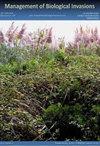Rapid response to water hyacinth (Eichhornia crassipes) invasion in the Guadalquivir river branch in Seville (southern Spain)
IF 1.2
4区 环境科学与生态学
Q3 BIODIVERSITY CONSERVATION
引用次数: 2
Abstract
A rapid response action carried out against the invasion of water hyacinth ( Eichhornia crassipes ) in the Guadalquivir River branch in Seville (Southern Spain) is described and analyzed. Removal was implemented and coordinated by the regional environmental Council, National security forces and public companies. Immediately after its detection, the distribution and abundance of water hyacinth, and the possible origin of introduction were assessed as the basis for selecting a feasible removal method. Plants were scattered across 110 ha and a perimeter of 8.4 km. A total biomass of 1,931 kg (fresh weight) was removed between May and December 2021 by combining manual removal from water using inflatable boats, floating booms, wetsuits and fishing waders, as well as removal from the shore. In total, the action cost ca. €22,500. Most biomass (83%) was removed during the initial control phase (one month). However, most of the efforts and costs (83%) were made in the following seven months, especially for monitoring and follow-up treatments. Rapid response avoided the growth, blooming and spread that could be expected in summer, coinciding with the optimal growing conditions. Moreover, rapid response reduced ca. 50 times the biomass and control costs with respect to a delayed action (i.e., after summer). Despite the fact that monitoring required a higher effort and cost than the initial control phase, it altogether represented a great cost saving as the invasion was kept at bay. The coordination between the regional Council, National security forces and public companies has taken advantage of the specific strengths of each one of them, achieving the shortest possible response time.西班牙南部塞维利亚瓜达尔基维尔河支流水葫芦入侵的快速反应
描述并分析了西班牙南部塞维利亚瓜达尔基维尔河支流水葫芦(Eichhornia crassipes)入侵的快速反应行动。清理工作由地区环境委员会、国家安全部队和上市公司执行和协调。在检测到水葫芦后,立即对水葫芦的分布、丰度、可能的传入来源进行评估,选择可行的去除方法。植物分布在110公顷的土地上,周长8.4公里。在2021年5月至12月期间,通过使用充气船、浮动吊杆、潜水服和钓鱼水车从水中手动移除,以及从岸上移除,总生物量为1,931千克(新鲜重量)。整个行动总共花费了22500欧元。大部分生物量(83%)在初始控制阶段(一个月)被去除。然而,大部分的努力和费用(83%)是在接下来的7个月,特别是监测和随访治疗。快速反应避免了预期在夏季的生长,开花和传播,恰逢最佳生长条件。此外,与延迟行动(即夏季之后)相比,快速反应减少了约50倍的生物量和控制成本。尽管监测比最初的控制阶段需要更多的努力和成本,但它总的来说是一笔巨大的成本节约,因为入侵被阻止了。区域委员会、国家安全部队和公共公司之间的协调利用了各自的具体优势,实现了尽可能短的反应时间。
本文章由计算机程序翻译,如有差异,请以英文原文为准。
求助全文
约1分钟内获得全文
求助全文
来源期刊

Management of Biological Invasions
Agricultural and Biological Sciences-Ecology, Evolution, Behavior and Systematics
CiteScore
3.40
自引率
6.70%
发文量
21
审稿时长
16 weeks
期刊介绍:
Management of Biological Invasions, established in 2010 by Dr. Elias Dana, is an open access, peer-reviewed international journal focusing on applied research in biological invasions in aquatic and terrestrial ecosystems from around the world. This journal is devoted to bridging the gap between scientific research and the use of science in decision-making, regulation and management in the area of invasive species introduction and biodiversity conservation.
Managing biological invasions is a crisis science, with Management of Biological Invasions aiming to provide insights to the issues, to document new forms of detection, measurements and analysis, and to document tangible solutions to this problem.
In addition to original research on applied issues, Management of Biological Invasions publishes technical reports on new management technologies of invasive species and also the proceedings of relevant international meetings. As a platform to encourage informed discussion on matters of national and international importance, we publish viewpoint papers that highlight emerging issues, showcase initiatives, and present opinions of leading researchers.
 求助内容:
求助内容: 应助结果提醒方式:
应助结果提醒方式:


